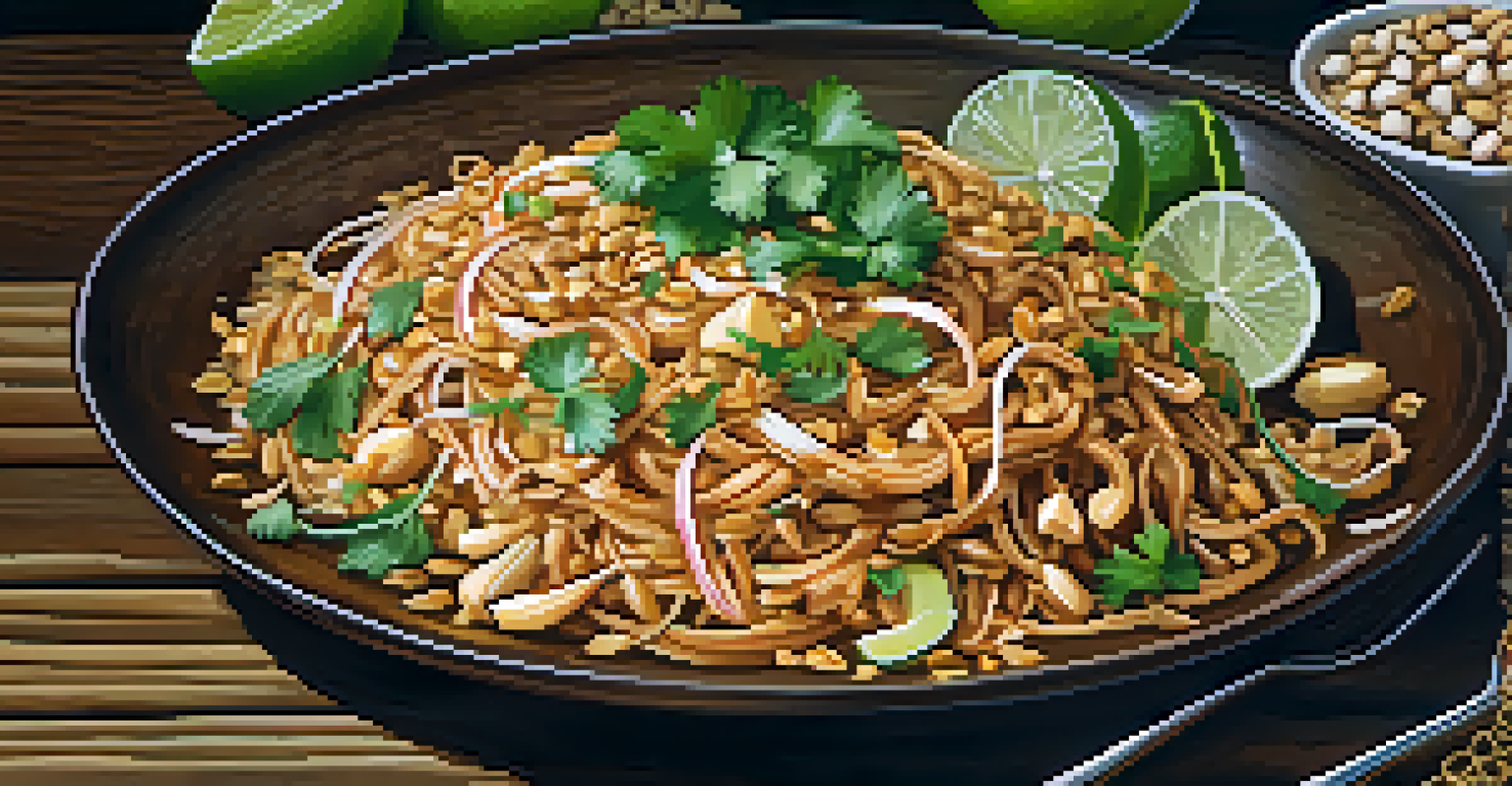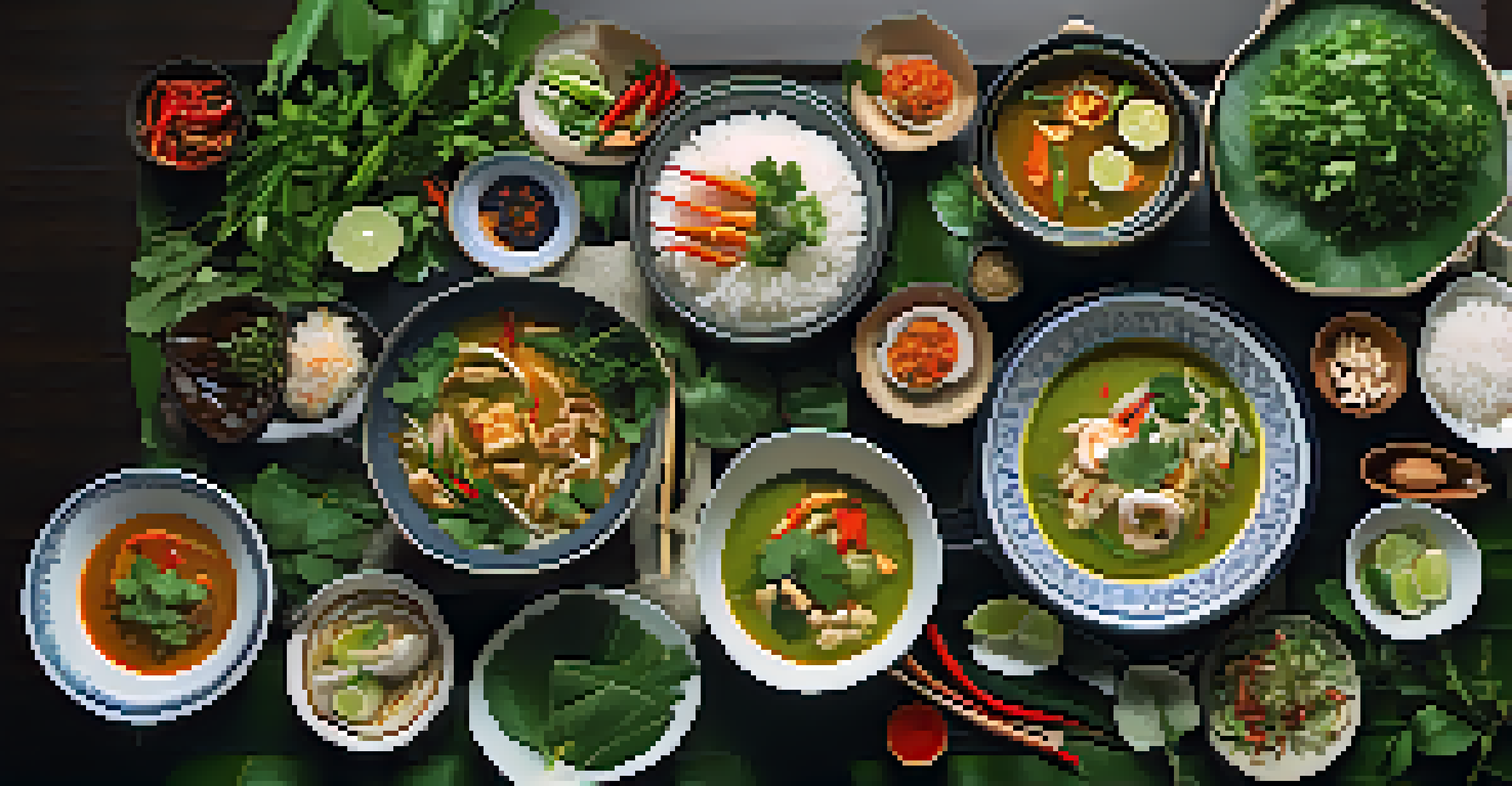Hands-On Cooking Classes: Mastering Thai Cuisine Techniques

Why Choose Hands-On Cooking Classes for Thai Cuisine?
Hands-on cooking classes offer a unique opportunity to dive deep into the flavors and techniques of Thai cuisine. Unlike watching a cooking show or reading a recipe, these classes allow you to get your hands dirty, literally and figuratively! You'll learn not just the 'how' but also the 'why' behind each technique, making the process more engaging and memorable.
Cooking is like love. It should be entered into with abandon or not at all.
Moreover, Thai cuisine is all about balance—sweet, sour, salty, and spicy. In a hands-on class, you'll get to taste and adjust flavors in real-time, helping you develop your palate. This immediate feedback loop is invaluable, as it builds your confidence in using fresh ingredients, herbs, and spices that define Thai cooking.
Finally, hands-on classes foster a sense of community. Cooking together creates a shared experience, making it easier to learn from both instructors and fellow participants. You might even leave with new friendships, along with the skills to whip up a delicious Thai feast!
Essential Thai Ingredients You’ll Master
One of the first things you'll encounter in a Thai cooking class is the array of vibrant ingredients that make this cuisine so special. From fragrant lemongrass to spicy bird's eye chilies, learning to identify and use these ingredients is crucial. Each ingredient has its own role, and understanding them will elevate your cooking.

You’ll also dive into staples like fish sauce, coconut milk, and palm sugar. These ingredients contribute to the unique umami and sweetness that Thai dishes are known for. Through hands-on practice, you'll learn how to balance these flavors effectively, enhancing your dishes and making them authentic.
Experience Thai Cooking Hands-On
Participating in hands-on cooking classes allows you to engage deeply with Thai cuisine, learning techniques and flavors in a memorable way.
Additionally, classes often emphasize the importance of fresh herbs like cilantro and Thai basil. You'll discover how to chop, store, and incorporate these herbs to create depth in your dishes. Mastering these essential ingredients will empower you to recreate authentic Thai meals at home with confidence.
Fundamental Techniques in Thai Cooking
In a hands-on cooking class, you'll quickly realize that mastering a few fundamental techniques can drastically improve your Thai cooking. Techniques like stir-frying and steaming are central to many Thai dishes. You'll learn how to control heat and timing to achieve the perfect texture and flavor.
The secret of good cooking is, first, having a love of it. If you’re not going to enjoy your cooking, then you might as well not do it.
Another key technique is making curry paste from scratch. You'll get to pound together fresh ingredients like chilies, garlic, and spices using a mortar and pestle, an experience that connects you to traditional methods. This not only enhances the flavor but also provides a sense of accomplishment.
Finally, knife skills are crucial in Thai cooking. You’ll practice precise chopping and slicing techniques that ensure even cooking and beautifully presented dishes. With the right skills, you can transform simple ingredients into a feast for the eyes and palate.
Cooking Popular Thai Dishes
Throughout the course, you’ll have the chance to prepare popular Thai dishes like Pad Thai, Tom Yum soup, and Green Curry. Each recipe allows you to apply the techniques and ingredients you've learned, providing a comprehensive experience. It’s incredibly satisfying to see your hard work turn into a delicious meal.
You’ll also learn to customize these dishes to suit your taste preferences, whether that means adjusting spice levels or adding extra veggies. This flexibility is a hallmark of Thai cuisine, making it accessible to everyone, regardless of dietary restrictions.
Master Essential Thai Ingredients
Understanding and using key Thai ingredients like fish sauce and lemongrass is crucial for creating authentic dishes.
As you cook, instructors will share stories and cultural insights about each dish, deepening your appreciation for the cuisine. By the end of the class, you won’t just have recipes; you’ll have a rich understanding of the culture behind the food.
The Role of Presentation in Thai Cuisine
In Thai cooking, presentation is just as important as taste. You’ll learn that a well-presented dish can elevate the dining experience, turning a simple meal into a feast for the senses. Vibrant colors, thoughtful plating, and garnishes like lime wedges or fresh herbs all play a role in making your dishes visually appealing.
Hands-on classes often include tips on how to plate your dishes attractively. You may experiment with different plating styles, learning how to arrange food in a way that highlights its textures and colors. This skill is invaluable, particularly if you plan to host a dinner party or impress friends and family.
Moreover, the emphasis on presentation encourages mindfulness while cooking. You’ll find yourself taking a moment to appreciate your creation before diving in, enhancing your overall cooking experience. It's a wonderful reminder that cooking is not just about sustenance, but also about art and enjoyment.
Tips for Practicing Thai Cooking at Home
After attending a hands-on cooking class, you’ll be eager to practice your newfound skills at home. Start by stocking your kitchen with essential Thai ingredients. Having the right staples on hand will make it easier to whip up dishes whenever the craving strikes.
Don't hesitate to revisit the recipes you learned in class. Use them as a foundation and experiment with different ingredients or methods. Think of it as a fun opportunity to get creative in the kitchen, allowing your personal taste to shine through.
Join a Supportive Cooking Community
Being part of a cooking community enhances your culinary journey by providing connections, inspiration, and shared experiences.
Lastly, consider inviting friends or family to join you in your Thai cooking adventures. Cooking can be a social activity, and sharing your culinary creations with others makes it even more rewarding. Plus, it’s a chance to showcase the skills you’ve developed in your cooking class!
The Benefits of Joining a Cooking Community
Engaging in a hands-on cooking class often connects you with a community of fellow food enthusiasts. This network can be incredibly beneficial as you continue your culinary journey. Sharing tips, tricks, and experiences can help you refine your skills and inspire new ideas.
Many cooking classes also offer online forums or social media groups where you can share your successes and challenges. Being part of such a community provides motivation and accountability, making your cooking practice more enjoyable and consistent.

Moreover, participating in cooking events, potlucks, or challenges can deepen your understanding of Thai cuisine. You’ll find that these communal experiences not only enhance your skills but also create lasting friendships centered around a shared passion for food.